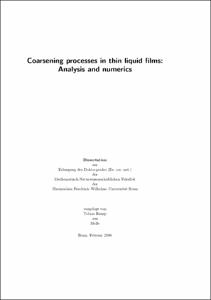Online-Ausgabe in bonndoc: https://nbn-resolving.org/urn:nbn:de:hbz:5N-14443
urn: https://nbn-resolving.org/urn:nbn:de:hbz:5N-14443,
author = {{Tobias Rump}},
title = {Coarsening processes in thin liquid films : Analysis and numerics},
school = {Rheinische Friedrich-Wilhelms-Universität Bonn},
year = 2008,
note = {
In my thesis, I study coarsening processes in thin liquid films on solid substrates. The evolution of the liquid film is determined by the so-called thin film equation. Such processes are investigated in film configurations of droplets, which are connected by a uniform thin liquid layer. Here, there coarseness of the configuration is characterized by the (decreasing) number of droplets. The dynamics is driven by the reduction of the total energy of the film, but limited by viscous friction. This balance is encoded in the gradient flow structure of the thin film equation.
For the rigorous analysis of the coarsening rates, I resort to an abstract framework which was originally established for the related Cahn-Hilliard equation. This method provides a lower bound on the energy in a time-averaged sense. A main contribution of my work is an interpolation inequality, which characterizes the geometry of the energy landscape. Heuristically, the lower bound on the energy yields an upper bound on the coarsening rate. Numerical simulations confirm these results in the case of one- and two-dimensional substrates.
The coarsening process is mediated by two competing mechanisms: the collapse of droplets, which relies on the mass transfer between droplets through the connecting thin film (i.e. a particularity of Ostwald ripening), and collision of migrating droplets. To understand the impact of both mechanisms on the process, each mechanism is studied separately in a model problem by means of asymptotic analysis. In particular, equations of motion and volume change are derived (depending on the mobility exponent of the thin film equation) in the regime of large, well-separated droplets.
To understand the interaction in many-droplet-configurations, I again employ the gradient flow structure of the problem. For that purpose, the configuration space is reduced by quasi-stationary assumption, so that I finally obtain a system of ODEs, which describes the energy descent. The ODE coefficients are determined to leading order with the help of the model problems. This reduced dynamics allows me to gain insight in the detailed interactions. For instance, the reduced model reveals that the migration of droplets is generated by the mass exchange between them. Furthermore, while a configuration of only two droplets never leads to collision, a configuration of two relatively small droplets surrounded by larger droplets can generically lead to collision. With the help of the typical time scales of both mechanisms, which can be derived from the system of ODEs, I identify the relative importance of collision to the coarsening process depending on the mobility exponent and the average film height.
Finally, numerical experiments validate the approximations made in the reduced model.
url = {https://hdl.handle.net/20.500.11811/3622}
}






